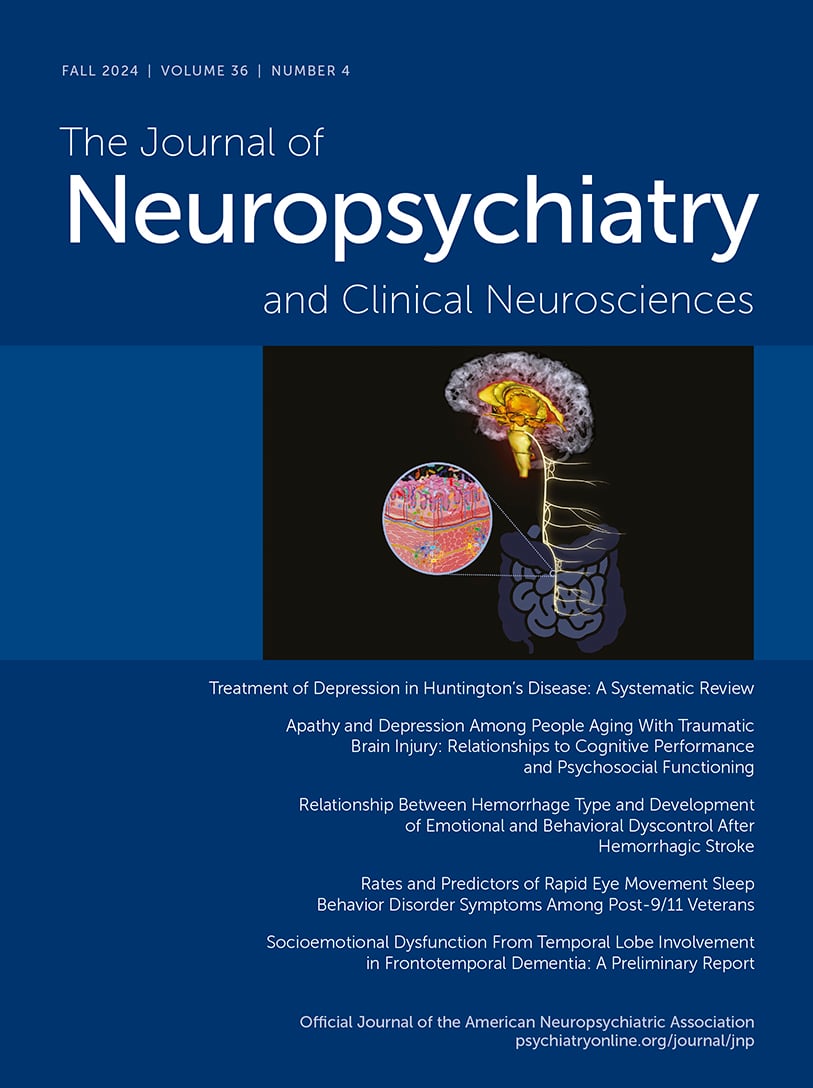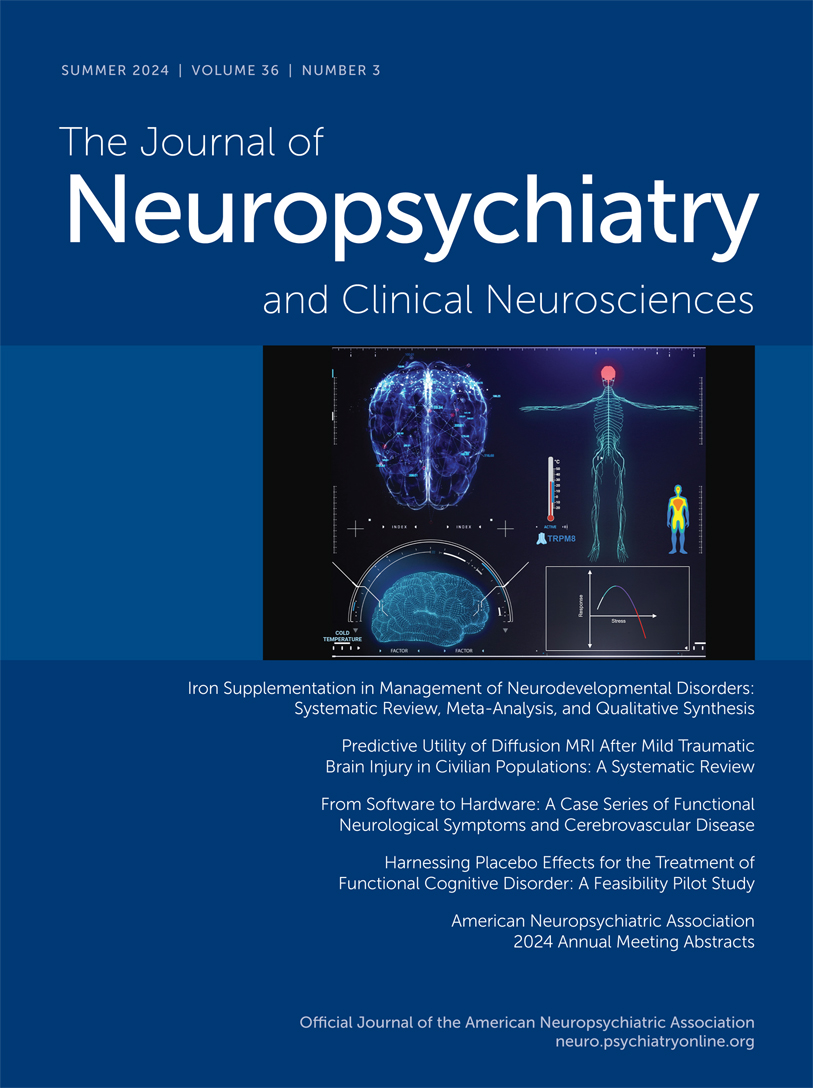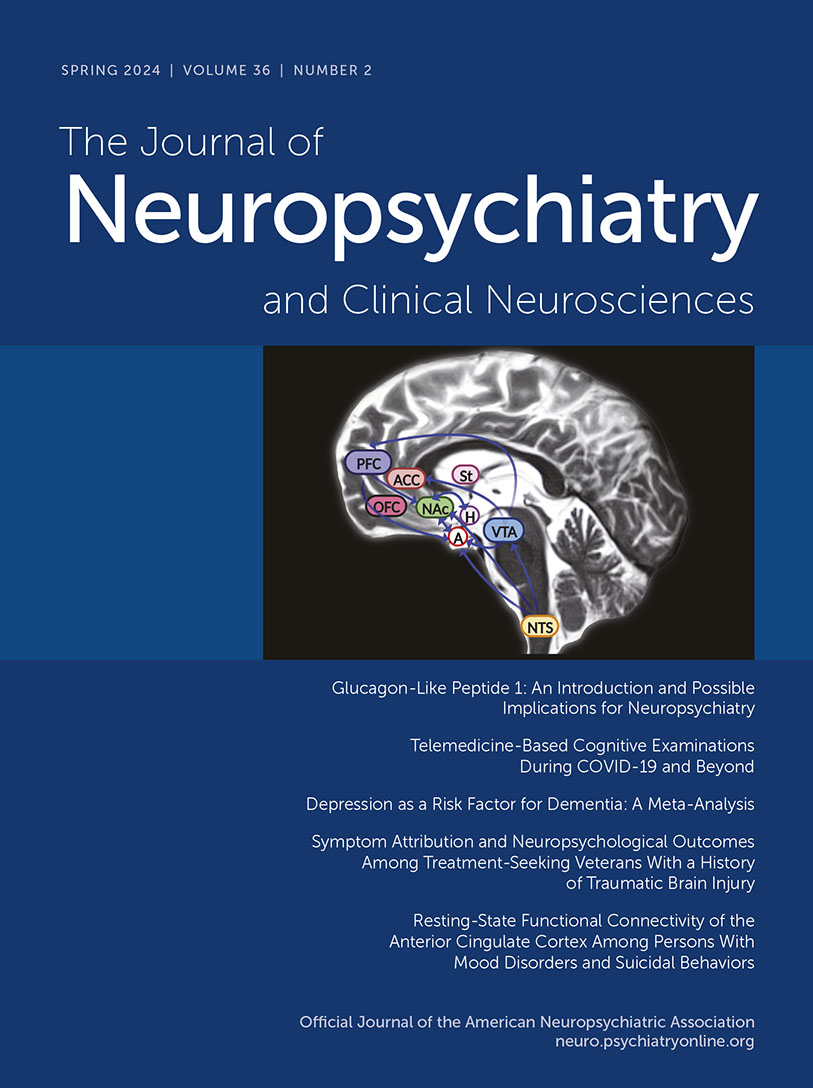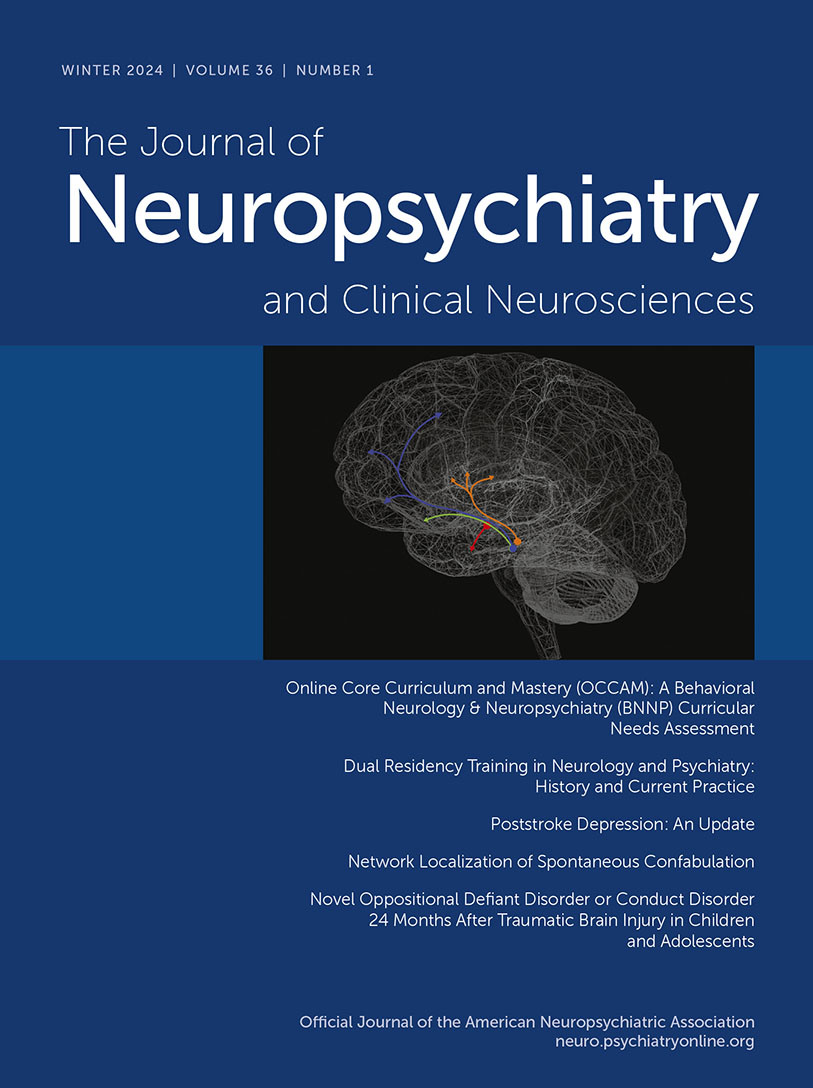The Journal of Neuropsychiatry and Clinical Neurosciences
- Volume 10
- Number 2
- May 1998
Special Article
Publication date: 01 May 1998
Pages125–132HIV-1–associated cognitive impairment has only been preliminarily investigated for associations with mortality. The authors examined 119 HIV-1–positive homosexual men (asymptomatic: n=96; early symptomatic: n=23). At follow-up (to 3.5 years), there were ...
https://doi.org/10.1176/jnp.10.2.125Publication date: 01 May 1998
Pages133–147Magnetic resonance spectroscopy (MRS) is a noninvasive tool for in vivo chemical analysis that has been applied to neurobiological or psychopharmacological studies of affective disorders. Studies employing 31P-MRS and 1H-MRS have indicated possible ...
https://doi.org/10.1176/jnp.10.2.133Publication date: 01 May 1998
Pages148–159Using a pharmacological probe, procaine hydrochloride, the authors elicited consistent and selective activation of anterior limbic and paralimbic structures in normal human volunteers as documented by H215O positron emission tomography. This activation ...
https://doi.org/10.1176/jnp.10.2.148Regular Article
Publication date: 01 May 1998
Pages160–167Tests of attention, inhibition, working memory, motor learning, and problem solving—functions associated with the brain's frontal systems—were administered to 26 children with attention-deficit/hyperactivity disorder and learning disabilities (ADHD+LD), ...
https://doi.org/10.1176/jnp.10.2.160Publication date: 01 May 1998
Pages168–177Using positron emission tomography and [18F]-2-fluoro-2-deoxy-d-glucose, the authors determined cerebral metabolic rates for glucose (CMRglc) in 39 adults (18–51 years old) with attention-deficit/hyperactivity disorder (ADHD) and 56 healthy control ...
https://doi.org/10.1176/jnp.10.2.168Publication date: 01 May 1998
Pages178–186Therapeutic effectiveness of electroconvulsive therapy is influenced by the degree to which the stimulus intensity exceeds the seizure threshold. However, the threshold rises variably over the treatment course, confounding maintenance of desired relative ...
https://doi.org/10.1176/jnp.10.2.178Publication date: 01 May 1998
Pages187–193Electroconvulsive therapy (ECT) has been used to treat the psychiatric complications of Parkinson's disease. Concurrent improvement of parkinsonian motor symptoms has been noted. This retrospective study compared the outcomes of 25 patients with ...
https://doi.org/10.1176/jnp.10.2.187Publication date: 01 May 1998
Pages194–198The delusional misidentification syndrome (DMS) has been associated with a range of neurological conditions. Three cases of DMS in patients with Parkinson's disease and dementia, treated with dopaminergic medications, are presented. It is postulated that ...
https://doi.org/10.1176/jnp.10.2.194Publication date: 01 May 1998
Pages199–204The authors studied 61 geropsychiatric patients with delirium from a cohort of 843 consecutive admissions to a geriatric clinical research unit. A central study goal was to assess how the presence of dementia affected the presentation of delirium. ...
https://doi.org/10.1176/jnp.10.2.199Publication date: 01 May 1998
Pages205–209The authors compared patients in a geropsychiatric unit who showed marked cognitive decline during hospitalization with those who did not. Patients who declined in cognitive function were older, were more likely to have a diagnosis of dementia, and were ...
https://doi.org/10.1176/jnp.10.2.205Publication date: 01 May 1998
Pages210–215This study evaluated the hypothesis that homeless individuals would display higher levels of neurological deficits than non-homeless individuals, particularly in frontal lobe or executive functions. Eighteen acutely homeless, 15 chronically homeless, and ...
https://doi.org/10.1176/jnp.10.2.210Clinical and Research Report
Publication date: 01 May 1998
Pages216–219Psychoses are a common clinical problem in patients with Parkinson's disease. Treatment with typical neuroleptics or withdrawal of antiparkinsonian drugs may improve mental symptoms but will worsen the parkinsonism. Quetiapine (Seroquel), ICI 204,636, is ...
https://doi.org/10.1176/jnp.10.2.216Publication date: 01 May 1998
Pages220–223The authors describe a series of 22 patients with dementia and behavioral disturbances, including agitation, aggression, delusions, and hallucinations, who were treated with risperidone. Risperidone, in low doses, was well tolerated; 50% of patients ...
https://doi.org/10.1176/jnp.10.2.220Publication date: 01 May 1998
Pages224–226d-cycloserine is a partial agonist on the glycine site of the N-methyl-d-aspartate glutamate receptor. This double-blind crossover study of 15 mg d-cycloserine in Alzheimer's disease patients did not demonstrate clinical benefit. Higher medication dosage ...
https://doi.org/10.1176/jnp.10.2.224Publication date: 01 May 1998
Pages227–229Dementia with Lewy bodies (DLB) may be one of the most common causes of dementia. It should be of particular interest to psychiatrists because hallucinations are common presenting symptoms and because patients with DLB may be particularly sensitive to ...
https://doi.org/10.1176/jnp.10.2.227Classic Article
Book Review
Letter
Past Issues
View Issues Archive
Vol. 36 | No. 4

Vol. 36 | No. 3

Vol. 36 | No. 2
